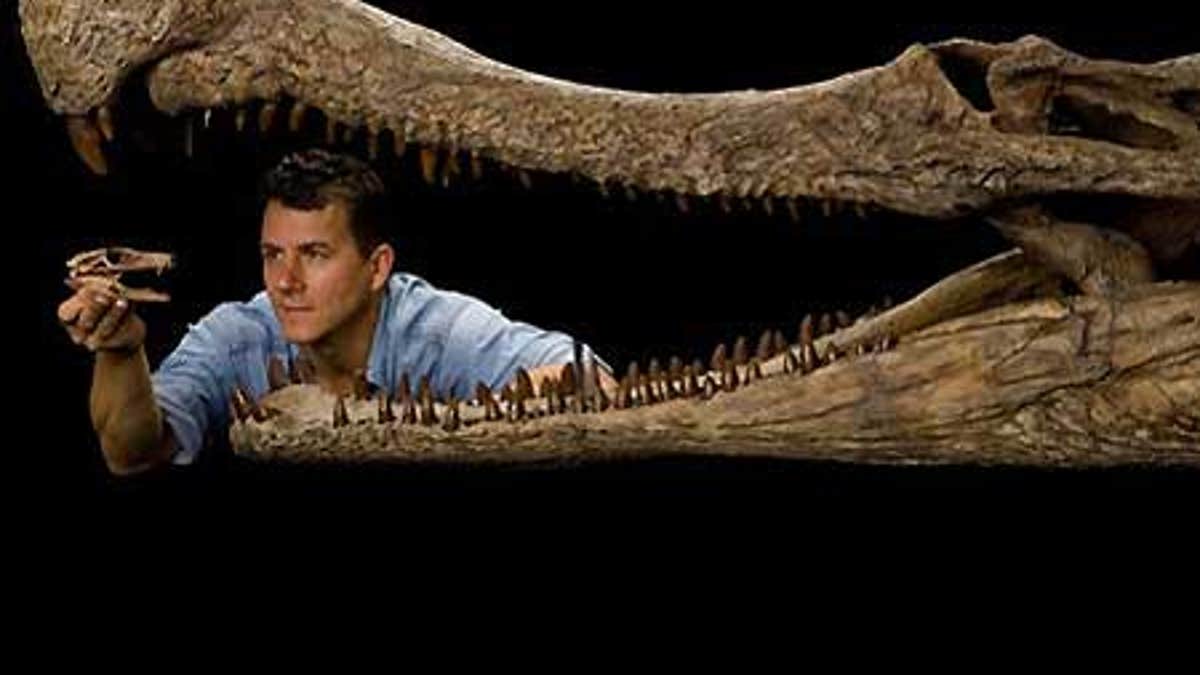
National Geographic Explorer-in-Residence, enveloped by the jaws of SuperCroc, holds the fossil head of DogCroc. (AP)
WASHINGTON – A 20-foot-long crocodile with three sets of fangs — like wild boar tusks — roamed parts of northern Africa millions of years ago, researchers report Thursday.
While this fearsome creature hunted meat, not far away another newly found type of croc with a wide, flat snout like a pancake was fishing for food.
And a smaller, 3-foot-long relative with buckteeth was chomping plants and grubs in the same region.
The three new species, along with new examples of two previously known ancient crocodiles, were being detailed Thursday by researchers Paul Sereno of the University of Chicago and Hans Larsson of McGill University in Montreal. They were speaking at a news conference organized by the National Geographic Society, which sponsored the research.
"These species open a window on a croc world completely foreign to what was living on northern continents," Sereno said of the unusual animals that lived 100 million years ago on the southern continent known as Gondwana.
The researchers suggest that these crocs could gallop across the landscape chasing prey and yet also dive into the water that then existed in the region and swim.
"My African crocs appeared to have had both upright, agile legs for bounding overland and a versatile tail for paddling in water," Sereno wrote in an article for National Geographic magazine. "Their amphibious talents in the past may be the key to understanding how they flourished in, and ultimately survived, the dinosaur era."
The newly discovered species are:
— Kaprosuchus saharicus, nicknamed "BoarCroc," found in Niger. BoarCroc was a 20-foot-long meat-eater with an armored snout for ramming and three sets of dagger-shaped fangs for slicing.
— Araripesuchus rattoides, which the researchers call "RatCroc," found in Morocco. This 3-foot-long croc was a plant- and grub-eater with a pair of buckteeth in lower jaw it used to dig for food.
— Laganosuchus thaumastos, or "PancakeCroc," found in Niger and Morocco. Also 20 feet long, it was a squat fish-eater with a 3-foot pancake-flat head and spike-shaped teeth on slender jaws. Sereno said it probably remained motionless for hours, its jaws open and waiting for prey.
In addition the researchers found new fossils of two previously named species:
— Anatosuchus minor, "DuckCroc," found in Niger, a 3-foot-long fish-, frog- and grub-eater with a broad snout and Pinocchio-like nose. Special sensory areas on the snout end allowed it to root around on the shore and in shallow water for prey. Its closest relative is in Madagascar.
— Araripesuchus wegeneri, or "DogCroc," found in Niger, a 3-foot-long plant- and grub-eater with a soft, doglike nose pointing forward.
Sereno has focused since 2000 on fossils in the Sahara Desert, his first find being Sarcosuchus imperator, a 40-foot-long creature that would have weighed 8 tons and which he called SuperCroc.
The new findings are detailed in the journal ZooKeys as well as National Geographic magazine and a documentary scheduled for Saturday on the National Geographic Channel.